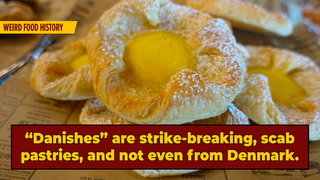Danishes: The Bastard Mistake Pastry No Country Wants to Claim

If you go to Denmark and order a Danish, the people behind the counter will be very confused and possibly suspect you of being the most incompetent human trafficker. That's because they call Danishes "wienerbrod," meaning "Viennese bread," or "Viennas." If you trek over to Vienna on some weird confectionary genealogical mission, however, you'll find that they call them "Copenhageners" because German never met a concept it could describe in fewer than 12 letters. Basically, Denmark and Austria have been shifting responsibility for the Danish onto each other for hundreds of years. Who came up with it, then? France. What?

According to our best sources, the Danish was invented by mistake by some Linguini-ass apprentice baker named Claudius Gelee in the early 17th century when he forgot to add butter to his dough, otherwise known as "just flour." He tried to cover up his mistake by just smashing chunks of butter in there and absolutely expected to be fired anyway, but the resulting pastry turned out pretty good. It was so good, in fact, that Gelee opened his own cafe in Paris and then another in Italy on the strength of his "a thousand leaves" pastry. As it made its way from Italy to Austria, however, France shuffled away to buy a pack of cigarettes, and that's when labor disputes got involved.
In 1850, the bakery workers of Denmark went on strike, so with a hankering for carbs and nowhere else to turn, Denmark shipped in a bunch of workers from Vienna. They didn't bother to train them on Danish cuisine, however, so all these Viennese bakers stepped off the proverbial bus, took a look around the kitchen, shrugged, and started making what they knew how to make, including the ... Danish. (It's not clear what the Viennese were calling it back then because there's little evidence of widespread clairvoyance among Viennese bakers.) Danishes became popular, so when the Danish bakers took their jobs back, they had to learn how to make them. When Danish people started immigrating en masse in the 20th century (including to Austria, where most people who didn't have their finger on the pulse of food production labor news were unaware of their own hand in the mixer), they brought the pastry with them, and everyone just started calling them "Danishes," presumably to the Danish's increasingly exasperated protest.
Don't Miss
Top Images: skoddeheimen/Pixabay